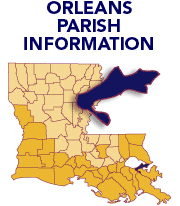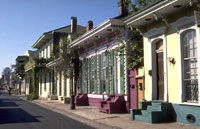 |
| |

Click on a parish to change parishes. |
| |
|
| |
|
| |
|
| |
|
| |
|
| |
PARISH PLANNING BASELINE |
|
|
|
|
| |
|
| |
| |
| |
|
| |
|
| |
 |
| |
|
|
|
 |
Orleans Parish
Nicknamed "The Big Easy," for its laid-back attitude, Orleans Parish might be the most famous mid-sized city in the world. Nestled between Lake Pontchartrain and the Mississippi River, the parish is the most populous in the state. Economic bread and butter come from the millions of visitors per year who join the party at Mardi Gras and Jazz Fest or just soak in the unique cultural mélange.
When asked what they treasured most about their community, Orleans Parish residents responded:
“We treasure our diversity, the historic architecture found throughout, Sundays at the French Market, family day in one of the parks (such as City, Audubon and Joe Brown), the unique food and music, and the people who call Orleans Parish home.”
|
|

 |
- The Superdome in New Orleans is the world's largest steel-constructed room unobstructed by posts.
- The Saint Charles streetcar line in New Orleans and the San Francisco cable cars are the nation's only mobile national monuments.
- Mardi Gras, the "greatest free show on earth," has rolled parades since 1856.
- Orleans Parish has 180 sq. miles in land area and a population density of 2,559.6 per square mile. In the last three decades of the 1900s, its population declined by 18.3%.
- The average household size is 2.48 persons compared to an average family size of 3.23 persons.
- In 2004 accommodation and food services was the largest of 20 major sectors. It had an average wage per job of $17,223. Per capita income grew by 17.6% between 1993 and 2003 (adjusted for inflation).
- The parish seat is New Orleans.
- Larger communities are the neighborhoods of metropolitan New Orleans.
- The parish was named for the French city Orleans and for a French nobleman, the Duke of Orleans. Settlement was at first discouraged by flooding and swamps; inmates from French prisons were brought in to build levees and fill in marshy areas. After the Louisiana Purchase of 1803, the city developed as a busy port for the steamboats and tall ships plying the Mississippi.
- Pre-storm, the population was 462,000.
- Significant economic interests are tourism, medical service and hospitals (public, private, and two university), manufacturing (including the Michoud Assembly Facility making rocket fuel tanks for the space shuttle), shipping, food processing, retail and warehousing, University of New Orleans, Tulane University.
|
|
|








